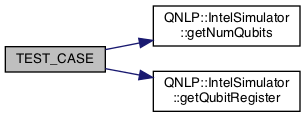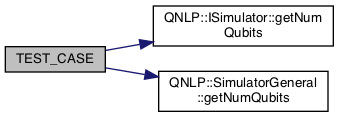Tests for the simulator interface. More...
#include "catch2/catch.hpp"#include "Simulator.hpp"#include "IntelSimulator.cpp"#include <memory>
Go to the source code of this file.
Functions | |
| TEST_CASE ("Intel-QS simulator creation","[simulator]") | |
| Tests creating a simulator (in this case, the Intel-QS), for a variety of different qubit counts, up to a max limit. More... | |
| TEST_CASE ("Pauli operators") | |
| Test the Pauli operators. More... | |
| TEST_CASE ("Simulator interface") | |
| Test the Simulator interface. More... | |
| TEST_CASE ("Measurement of qubits") | |
| Test the measurement of qubits. More... | |
| TEST_CASE ("Encoding even distribution: Unique Binary Patterns") | |
| Test the encoding of binary patterns into a superposition of states into an even distribution. More... | |
| TEST_CASE ("Hamming distance check") | |
| Test the Hamming distance delivers an appropriate distribution quantifying the similarity between a test state and a superposition of states. More... | |
Detailed Description
Tests for the simulator interface.
- Version
- 0.1
- Date
- 2019-05-07
- Copyright
- Copyright (c) 2019
Definition in file test_simulator.cpp.
Function Documentation
◆ TEST_CASE() [1/6]
| TEST_CASE | ( | "Intel-QS simulator creation" | , |
| "" | [simulator] | ||
| ) |
Tests creating a simulator (in this case, the Intel-QS), for a variety of different qubit counts, up to a max limit.
Definition at line 27 of file test_simulator.cpp.
References QNLP::IntelSimulator::getNumQubits(), QNLP::IntelSimulator::getQubitRegister(), and ncu_opt_tester::num_qubits.

◆ TEST_CASE() [2/6]
| TEST_CASE | ( | "Pauli operators" | ) |
Test the Pauli operators.
Definition at line 41 of file test_simulator.cpp.
References ncu_opt_tester::sim.
◆ TEST_CASE() [3/6]
| TEST_CASE | ( | "Simulator interface" | ) |
Test the Simulator interface.
Definition at line 95 of file test_simulator.cpp.
References QNLP::ISimulator::getNumQubits(), QNLP::SimulatorGeneral< DerivedType >::getNumQubits(), and QNLP.tagging.test_tagging::s1.

◆ TEST_CASE() [4/6]
| TEST_CASE | ( | "Measurement of qubits" | ) |
Test the measurement of qubits.
Definition at line 127 of file test_simulator.cpp.
References ncu_opt_tester::num_qubits, and ncu_opt_tester::sim.
◆ TEST_CASE() [5/6]
| TEST_CASE | ( | "Encoding even distribution: Unique Binary Patterns" | ) |
Test the encoding of binary patterns into a superposition of states into an even distribution.
Definition at line 175 of file test_simulator.cpp.
References QNLP_Python_MPI::reg_auxiliary, ncu_opt_tester::sim, and ncu_opt_tester::target.
◆ TEST_CASE() [6/6]
| TEST_CASE | ( | "Hamming distance check" | ) |
Test the Hamming distance delivers an appropriate distribution quantifying the similarity between a test state and a superposition of states.
Definition at line 241 of file test_simulator.cpp.
References QNLP_Python_MPI::reg_auxiliary, ncu_opt_tester::sim, and ncu_opt_tester::target.
